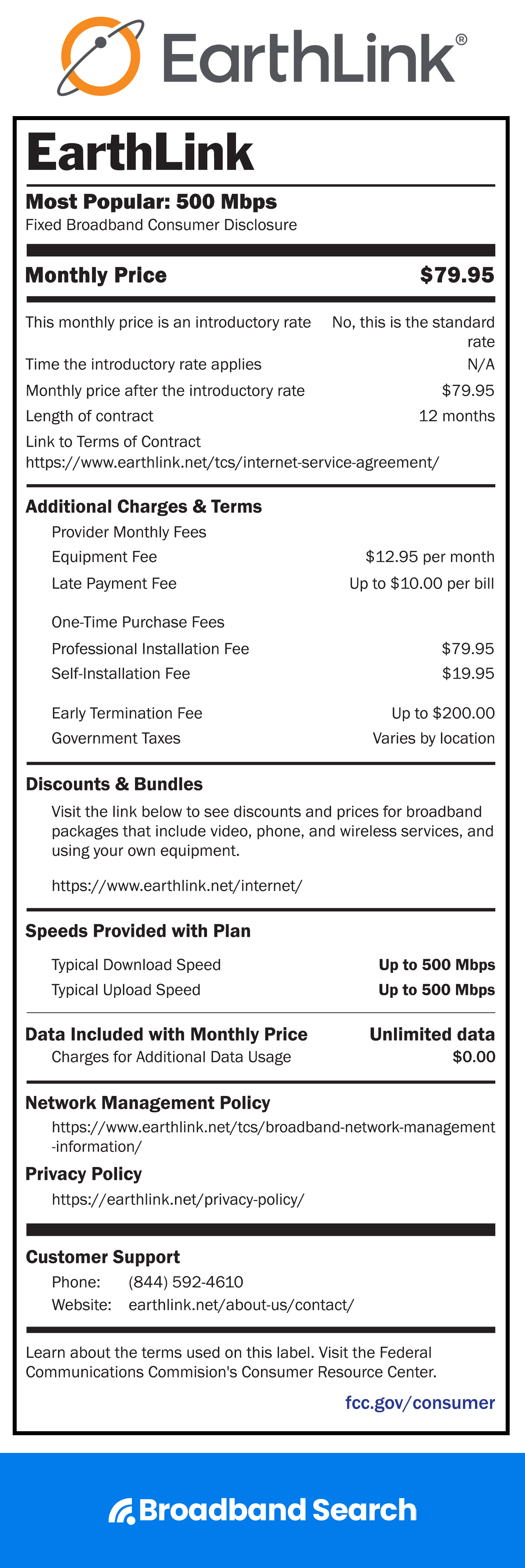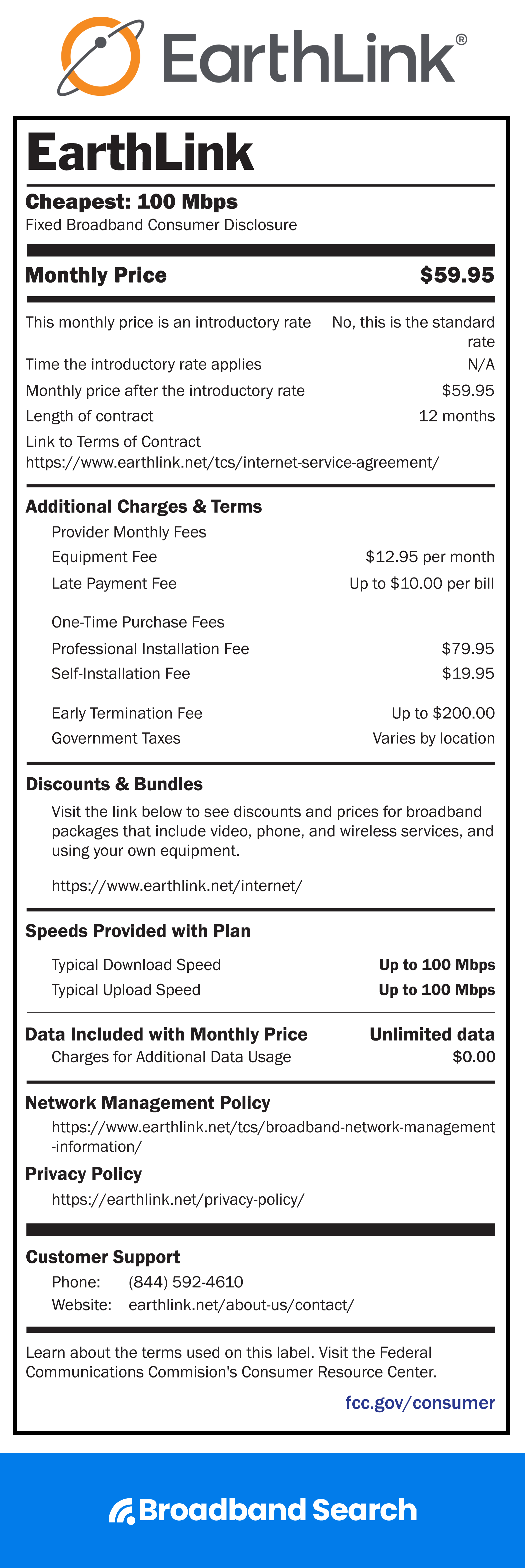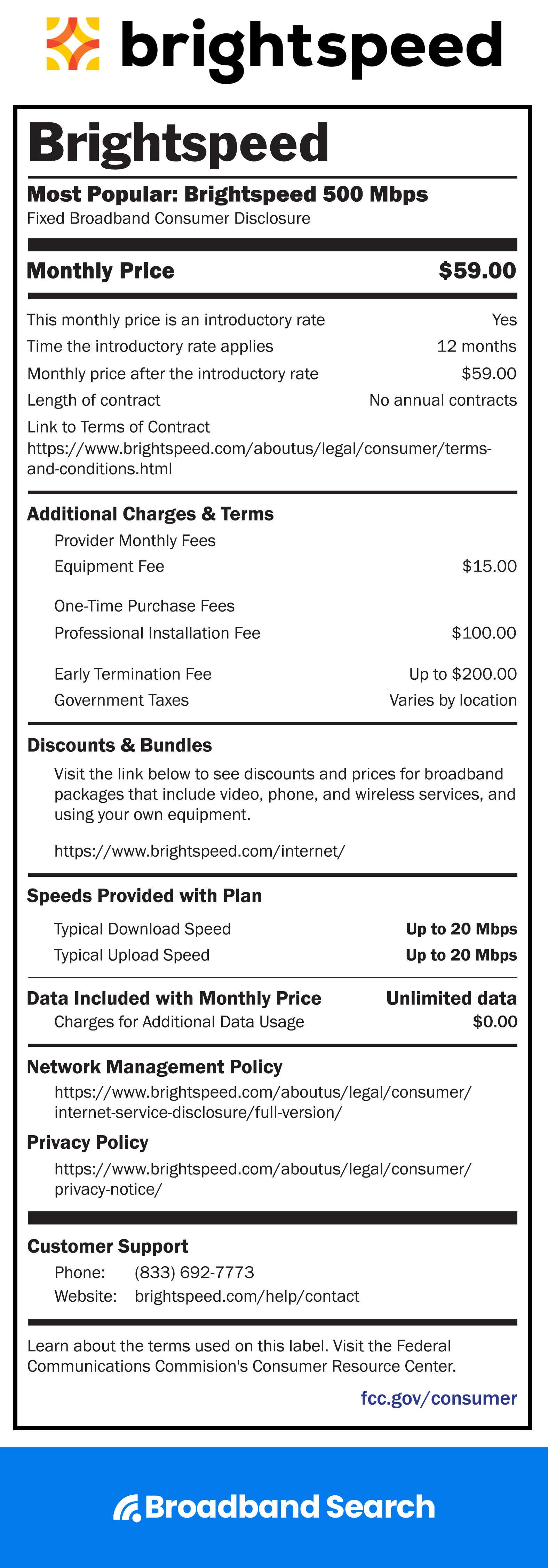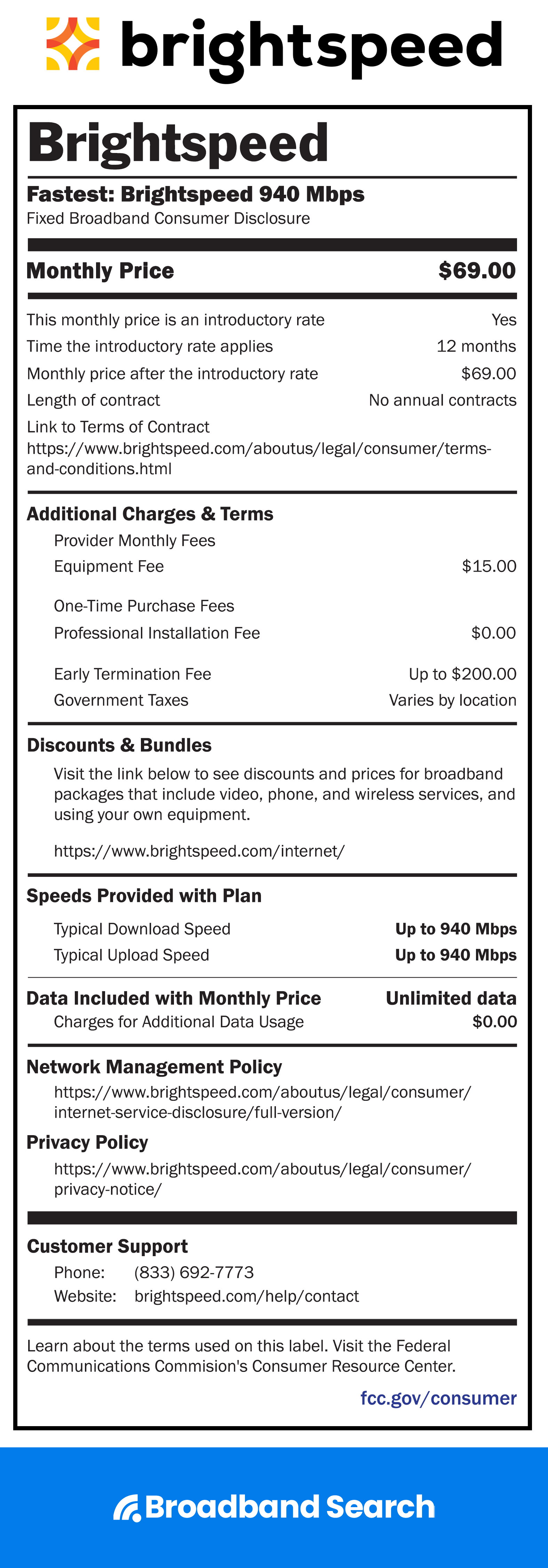The FCC has mandated that ISPs introduce clear "nutrition facts" style labels for broadband services, a rule that took effect on April 10, 2024. This initiative is designed to demystify internet packages plans for consumers, presenting details like speeds, prices, and data caps.
Surprisingly, no providers have yet complied with the new requirements, leaving a gap in consumer information.
Our goal with these broadband nutrition labels is to foster a more transparent and consumer-friendly marketplace. By providing essential information at a glance, we empower consumers to make choices that align with their preferences and requirements.
The FCC Broadband Facts Label
Xfinity by Comcast
EarthLink
Verizon Fios
AT&T
Cox Communications
Spectrum (Charter Communications)
WOW!
CenturyLink
Frontier Communications
Optimum
Kinetic by Windstream
Brightspeed
Comparing Broadband Services
Most Popular Broadband Services
When you're shopping around for broadband services, popularity can be a strong indicator of reliability and customer satisfaction. Here’s what typically drives a broadband service’s popularity:
- Quality of Service: Consistent, reliable internet connectivity wins customer trust.
- Customer Support: Effective problem resolution and courteous support retain customers.
- Price: Competitive pricing attracts and maintains a user base.
- Speed: Fast speeds for downloading and streaming make a service appealing.
- Reputation: Positive word-of-mouth and good reviews boost a provider’s image.
Fastest Broadband Services
In broadband terms, speed really matters, especially as it impacts activities like streaming, gaming, and downloading large files. The FCC’s introduction of Broadband Facts labels has made it easier to understand and compare these speeds clearly?.
- Verizon Fios: Offers reliable fiber-optic speeds that are great for high-demand users.
- Xfinity: High speeds across a wide coverage area, suitable for households with multiple users.
- AT&T Fiber: Strong performance with symmetrical upload and download speeds.
Cheapest Broadband Services
The cost information on broadband labels helps consumers understand monthly fees, one-time charges, and any potential hidden costs. This transparency allows for a straightforward comparison of how much the broadband service will cost over time?.
However, it's essential to consider the trade-off between cost and quality. Opting for the cheapest service might save money initially, but it could lead to frustration if the speed and reliability are subpar.
- Spectrum: Known for straightforward, competitive pricing without unexpected fees.
- Cox: Offers various introductory deals that can be cost-effective for new customers.
- Frontier: Often provides lower-cost options in service areas without much competition.
- Mediacom: Offers budget-friendly plans, especially in bundled services
- CenturyLink: Known for price-for-life deals on certain plans.
Broadband Labels in Consumer Decision-Making
Enhancing Consumer Awareness
These labels detail essential information aimed at helping consumers understand what they're paying for and how the service fits their needs, whether for streaming, gaming, or general browsing.
Key information on these labels includes:
- Typical Service Speeds: Clearly stated speeds to help consumers choose the right plan for activities like streaming HD video or gaming.
- Price Transparency: Disclosures of monthly fees, any introductory rates, and the price after such promotions end.
- Contract and Fees: Information about the length of the contract required, any one-time fees such as installation charges, and potential cancellation fees.
- Data Caps and Overages: Details on the limits of data usage and the costs if these limits are exceeded.
- Fair Usage Policies: Policies that prevent data abuse to ensure fair access to resources for all users.
Influencing Industry Standards
Pressure on Internet Service Providers (ISPs) to Improve Transparency
By standardizing what must be disclosed in a Broadband Facts Label, ISPs are encouraged to be more straightforward about their offerings. Several ISPs have responded by revamping their marketing strategies to be more transparent and consumer-friendly. Examples of such ISPs include:
- AT&T: Updated their presentation of broadband labels to make service fees and terms more transparent.
- Verizon: Adjusted marketing strategies to better align with the new requirements by explicitly detailing service speeds and costs.
- Comcast: Overhauled its approach by detailing each component of their service, ensuring consumers understand what they are paying for before making a decision.
- Cox Communications: Revamped online interfaces to display fees and terms more prominently.
- Charter Spectrum: Introduced clearer labeling on their websites and in physical stores.
Trends in Regulatory Changes
The introduction of the Broadband Facts Label has directly catalyzed regulatory changes and influenced how broadband services are marketed and managed. This change stems from the Infrastructure Investment and Jobs Act, which directed the Federal Communications Commission (FCC) to require providers to create consumer-friendly labels. These labels have set a new standard, encouraging a global shift towards greater transparency in broadband services.
Here's how different countries have responded:
- Canada: Introduced similar transparency regulations for ISPs, emphasizing clear disclosure of pricing and data caps.
- United Kingdom: OFCOM has pushed for greater clarity in broadband advertising to prevent misleading claims.
- Australia: Adopted labels that detail broadband speeds during peak times to better inform consumers.
- Germany: Recently implemented regulations requiring ISPs to provide digital fact sheets on service offerings.
- France: Enhanced consumer protection with mandatory disclosure of network management policies.
Predictions on Future Regulations
- Introduction of Global Standards: As broadband services become increasingly integral worldwide, there's a push for global standards to ensure consistency and transparency across borders, facilitating easier comparison and choice for consumers globally. This aligns with trends in other consumer protection areas where global standards have been beneficial.
- Enhanced Consumer Rights: Regulations ensuring that consumers can exit contracts without penalties if speeds aren’t met are likely due to growing dissatisfaction with service discrepancies. This would be a natural progression in strengthening consumer rights, similar to other service guarantees?.
- Real-Time Speed Disclosure: The demand for real-time speed information on ISPs’ websites could be driven by an increasing consumer preference for real-time data in other aspects of digital life. It’s a logical step to ensure ISPs provide what they advertise continuously, enhancing service trust and reliability.
- Expansion of Label Requirements: The trend towards more comprehensive disclosures, as seen in financial and environmental regulations, indicates a potential expansion in broadband labeling to include additional factors like environmental impact scores. This is in line with the broader regulatory shift towards encompassing more detailed and varied information.
- Greater Enforcement: Given the foundational role of the internet in modern life and the critical nature of transparency about service quality, increased penalties for non-compliance would enforce adherence to these standards, ensuring that the labels are taken seriously by ISPs and provide real value to consumers?.
Challenges and Solutions in Broadband Label Implementation
Technology and Infrastructure Requirements
The successful implementation of Broadband Facts Labels hinges on robust technological frameworks and infrastructure. ISPs must develop systems that ensure data monitoring and reporting are both accurate and timely. These technologies are essential for ISPs to effectively manage and track user data and service quality.
Challenges in maintaining accuracy and timeliness include:
- Data Accuracy: Ensuring the data displayed on labels reflects real-time usage and service conditions.
- System Integration: Integrating label systems with existing ISP infrastructures without disrupting service.
- Compliance Monitoring: Regularly verifying that label information meets regulatory standards.
- Update Frequency: Keeping the labels current with frequently changing service terms and technology upgrades.
- Consumer Accessibility: Making sure that all consumers, regardless of technical ability, can understand and access the labels.
Wrapping Up
The Broadband Facts Label has transformed the way consumers understand and choose their internet services, promoting transparency and informed decision-making. As technology evolves, further enhancements to these labels are anticipated, ensuring they remain relevant and effective in the face of new industry trends, such as the rise of 5G and enhanced consumer data rights.
For savvy consumers, using these labels to compare services is not just a recommendation—it's a must to navigate the complexities of modern broadband offerings effectively. "Knowledge is power," and these labels certainly put the power back in the hands of the consumer.
FAQ
How often must the information on the Broadband Facts Label be updated?
Internet Service Providers (ISPs) are required to update the Broadband Facts Label each time they change any of the details about an available plan. This ensures that all information remains current and accurate for consumers at the point of purchase.
Where can consumers find the Broadband Facts Label?
Consumers will soon be able to find the Broadband Facts Label online and at retail locations where broadband services are offered. These labels are designed to be clearly displayed alongside broadband service promotions, ensuring they are easily visible to consumers evaluating internet plans.
How does the Broadband Facts Label help in comparing different ISPs?
The Broadband Facts Label provides standardized information on internet speeds, pricing, data allowances, and additional fees. By presenting this information clearly, the label empowers consumers to make informed decisions based on their specific internet needs.
Are there penalties for ISPs that do not comply with the Broadband Facts Label requirements?
Yes, ISPs that do not comply with the Broadband Facts Label requirements can face significant penalties, including fines . The FCC enforces these regulations strictly to ensure transparency and consumer protection in broadband services. While specific fine amounts can vary depending on the severity and nature of the non-compliance, past enforcement actions have shown that fines can be substantial, often reaching into the millions of dollars for serious violations across various sectors regulated by the FCC.
Can the Broadband Facts Label be disputed or challenged by consumers?
Consumers can challenge or file complaints about the accuracy or adequacy of the information on the Broadband Facts Label through the FCC's Consumer Complaint Center.



































